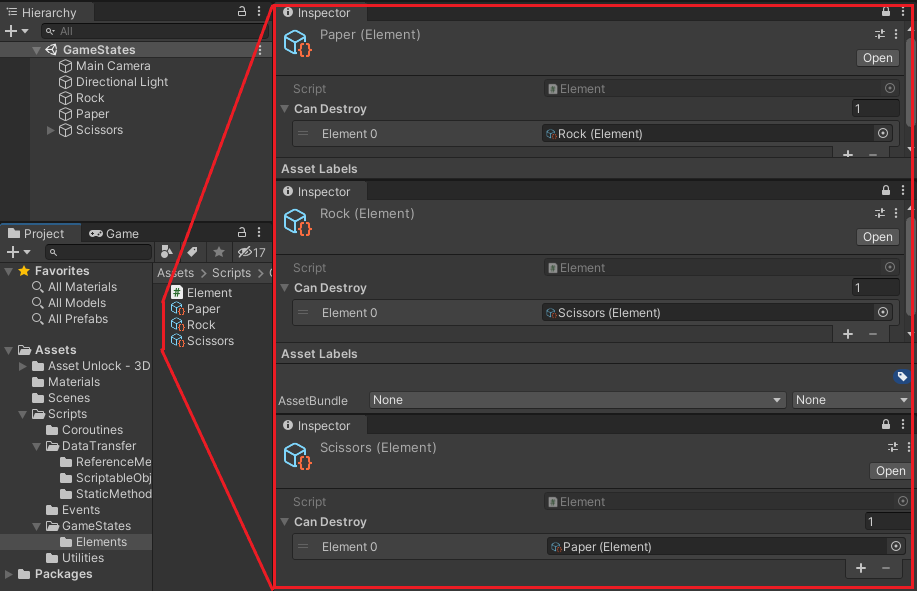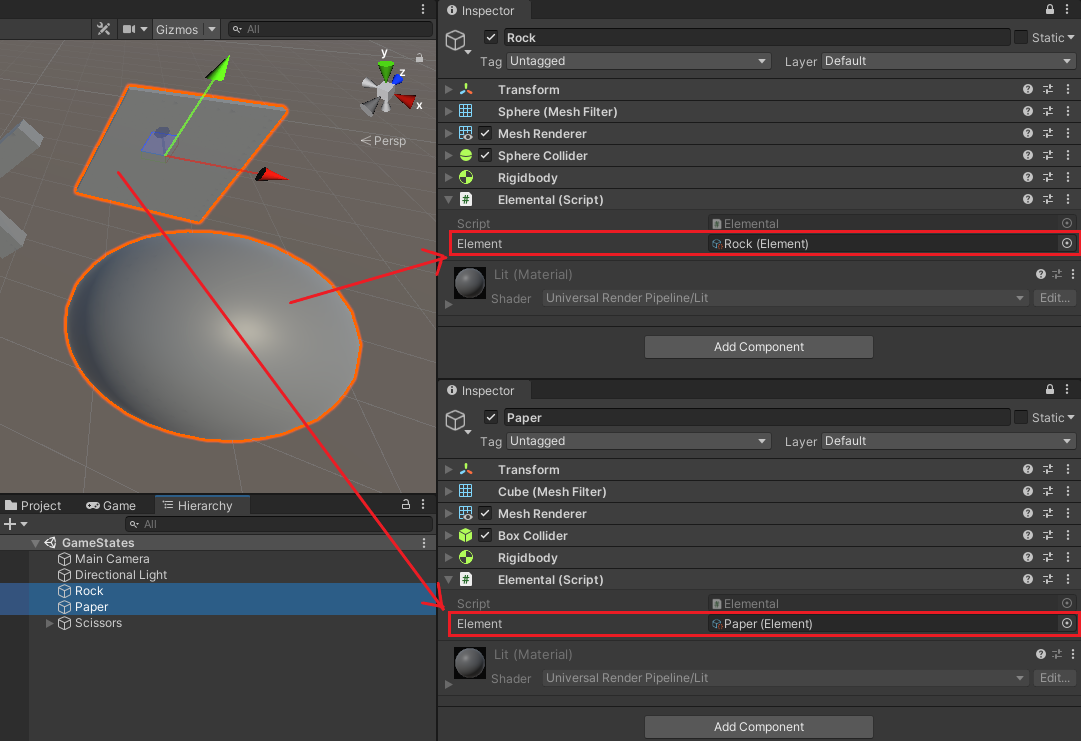States
Overview
In games sometimes you need to track the state of things. For Example:
The Direction you are traveling: North, South, East, West
The player’s health: 1-3
The action your player is performing: Idle, Walk, Run, Attack
Items in a chest: Food, Weapons, Money
Game State: InGame, InMenu, Victory, GameOver
Weapon Types: Stabbing, Blugeoning, Magical
This section covers several ways on how to manage game state logic.
State Example: Rock Paper Scissors
The examples in this section demonstrate the following behaviors:
There exists game objects in the scene with a state of Rock, Paper, and Scissors
When these game objects collide the loser is destroyed (rock collides with scissors -> scissors is destroyed)
The examples in this section also explore the following questions:
If we we add a new state to the scene (“Dynamite”) that can destroy Rock, Paper, Scissors and Dynamite, how difficult is it to implement it given the existing game structure?
Using Enum States
Tip
Enums are good for a fixed number of elements. If you anticipate adding additional elements in the future be prepared to make extensive edits to your code, especially if many scrips reference the enum.
Base Implementation
Elemental
Defines an enum
Elementwith items “Rock”, “Paper”, and “Scissors”Has a
ElementattributeHas a method that detects if it can destroy another element
OnTriggerEnter destroys the other game object if the other contains an element it can destroy.
The Elemental class.
using UnityEngine;
using System;
public class Elemental : MonoBehaviour
{
public enum Element
{
Rock,
Paper,
Scissors
}
public Element element;
public bool CanDestoryElement(Element otherElement)
{
switch (otherElement)
{
case Element.Rock:
return element == Element.Paper;
case Element.Paper:
return element == Element.Scissors;
case Element.Scissors:
return element == Element.Rock;
default:
throw new ArgumentOutOfRangeException(nameof(otherElement), otherElement, null);
}
}
private void OnTriggerEnter(Collider other)
{
Elemental otherElemental = other.gameObject.GetComponent<Elemental>();
if (otherElemental != null)
{
if (CanDestoryElement(otherElemental.element))
{
Destroy(other.gameObject);
}
}
}
}
Game objects with Elemental components in the scene.

Adding Dynamite Implementation
Had to add a new enum to the
Elementenum.Had to update the logic of CanDestoryElement. Had to add a switch case for Dynamite and had to account for the Dynamite under other cases.
The Elemental class with Dynamite.
using UnityEngine;
using System;
public class Elemental : MonoBehaviour
{
public enum Element
{
Rock,
Paper,
Scissors,
Dynamite,
}
public Element element;
public bool CanDestoryElement(Element otherElement)
{
switch (otherElement)
{
case Element.Rock:
return element == Element.Paper || element == Element.Dynamite;
case Element.Paper:
return element == Element.Scissors || element == Element.Dynamite;
case Element.Scissors:
return element == Element.Rock || element == Element.Dynamite;
case Element.Dynamite:
return element == Element.Dynamite;
default:
throw new ArgumentOutOfRangeException(nameof(otherElement), otherElement, null);
}
}
private void OnTriggerEnter(Collider other)
{
Elemental otherElemental = other.gameObject.GetComponent<Elemental>();
if (otherElemental != null)
{
if (CanDestoryElement(otherElemental.element))
{
Destroy(other.gameObject);
}
}
}
}
Using Scriptable Object States
This example code was created from Unite Austin 2017 - Game Architecture with Scriptable Objects
Base Implementation
Element
A Scriptable Object
Contains a list (
CanDestory) of elements that it can destroy
Elemental
Has a
ElementattributeOnTriggerEnter destroys the other game object if it contains an element that is present in the Element’s
CanDestoryList
In the Unity Editor
Next create 3 scriptable object assets from
Elementand name them Rock, Paper, and ScissorsInside the Rock asset, we add Scissors to the
CanDestoryList. This repeats similarly for Paper and Scissors.
The Element scriptable object.
using System.Collections.Generic;
using UnityEngine;
// The CreateAssetMenu attribute allows us to create scriptable object assets in the editor
// In the Editor: Right Click > Create > ScriptableObjects > GameEvent
[CreateAssetMenu(fileName = "New Element", menuName = "ScriptableObjects/Element")]
public class Element : ScriptableObject
{
[Tooltip("The elements this element can destroy")]
public List<Element> CanDestroy = new List<Element>();
}
The Elemental class.
using UnityEngine;
public class Elemental : MonoBehaviour
{
public Element element;
private void OnTriggerEnter(Collider other)
{
Elemental otherElemental = other.gameObject.GetComponent<Elemental>();
if (otherElemental != null)
{
if (element.CanDestroy.Contains(otherElemental.element))
{
Destroy(other.gameObject);
}
}
}
}
Element Scriptable Object Assets + Game objects with Elemental components.


Adding Dynamite Implementation
We create a new scriptable object assets from
Elementand name it DynamiteInside the Dynamite asset, we add Rock, Paper, and Scissors to the
CanDestoryList.
Dynamite asset + Dynamite Game Object

Scriptable Object Variables
Lets say you have a scene with the name level_0 and you use the string level_0 in some of your scripts.
Maybe at some point you change the level name or you want the level to be replaced by a scene with the name level_1.
In this scenario you would have to track down each use of the level_0 string and replace it with level_1. Instead
of repeating this process every time the scene name is altered, you could make a reference to a scriptable object
storing the strings value. Now if the string needs to be altered all you would have to do is change the string inside
the scriptable object.
Implementation
FloatVariable
A scriptable object that Contains the property
valuewith the type float
FloatReference
Contains a property
floatVariableof typeFloatVariableas well as property ofconstantValueof typefloatThe user can opt to use the value of the constant or float variable by specifying the boolean property
useConstantscripts retrieve a float from FloatReference using the
valueproperty.
Other scriptable objects of different types can be built off of the same framework of the 2 above classes.
The FloatVariable scriptable object and Float Reference class:
using UnityEngine;
using System;
[CreateAssetMenu(fileName = "New FloatVariable", menuName = "ScriptableObjects/Variables/FloatVariable")]
[Serializable]
public class FloatVariable : ScriptableObject
{
public float value;
}
using System;
[Serializable]
public class FloatReference
{
public bool useConstant;
public float constantValue;
public FloatVariable floatVariable;
public float value
{
get
{
if (useConstant)
{
return constantValue;
}
else
{
return floatVariable.value;
}
}
}
}
The StringVariable scriptable object and StringReference class:
using UnityEngine;
using System;
[CreateAssetMenu(fileName = "New StringVariable", menuName = "ScriptableObjects/Variables/StringVariable")]
[Serializable]
public class StringVariable : ScriptableObject
{
public string value;
}
using System;
[Serializable]
public class StringReference
{
public bool useConstant;
public string constantValue;
public StringVariable stringVariable;
public string value
{
get
{
if (useConstant)
{
return constantValue;
}
else
{
return stringVariable.value;
}
}
}
}
An example script that uses scriptable object variables:
using UnityEngine;
public class TestScript : MonoBehaviour
{
public FloatVariable health;
public FloatReference healthReference;
public StringVariable name;
public StringReference nameReference;
private void Start()
{
InteractWithFloatVariable();
InteractWithStringVariable();
}
private void InteractWithFloatVariable()
{
Debug.Log($"Health equals {health.value}");
health.value += 1;
Debug.Log($"Adding 1 to health");
Debug.Log($"New Health equals {health.value}");
Debug.Log($"Health reference equals {healthReference.value}");
}
private void InteractWithStringVariable()
{
Debug.Log($"Name equals {name.value}");
name.value += "bob";
Debug.Log($"Adding 'bob' to Name");
Debug.Log($"New Name equals {name.value}");
Debug.Log($"Name reference equals {nameReference.value}");
}
}
Example
Click to download ScriptableObjectVariablesExample.unitypackage.